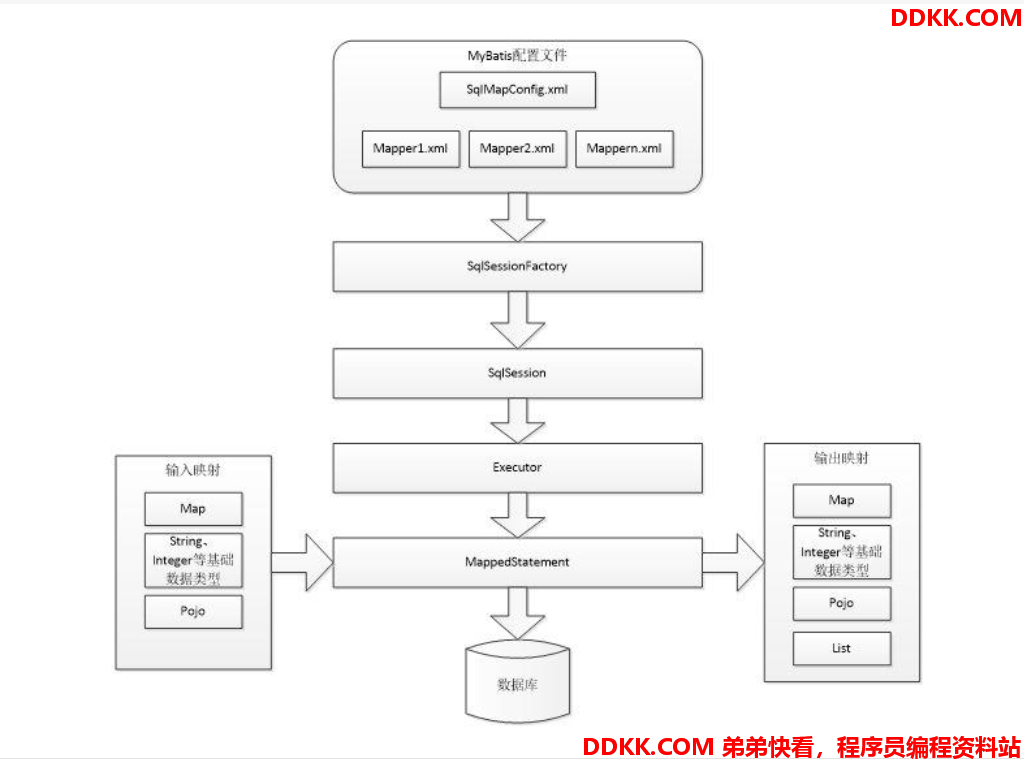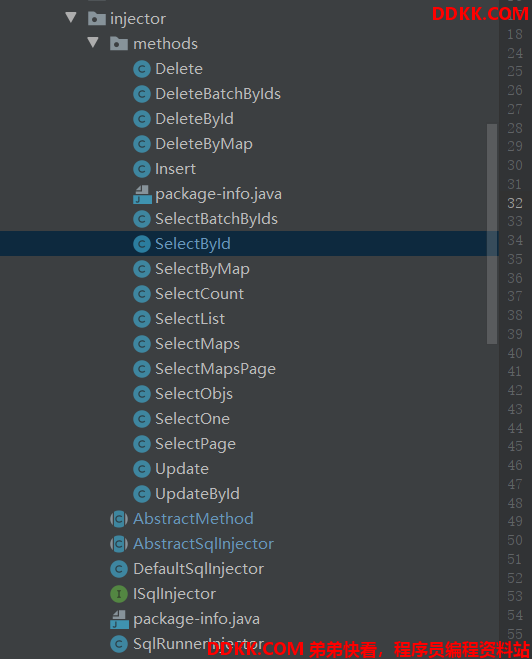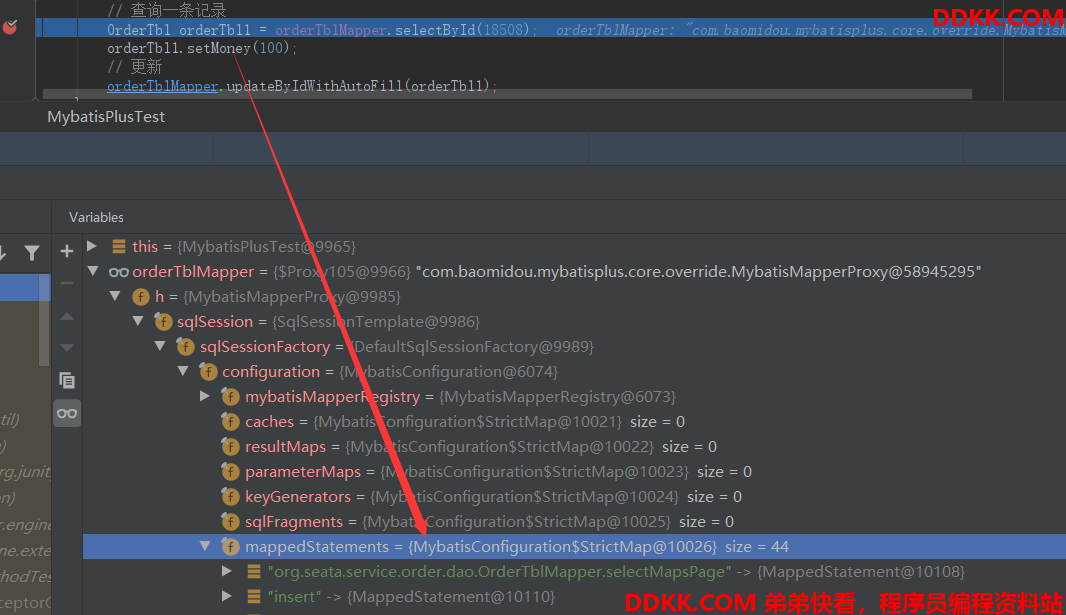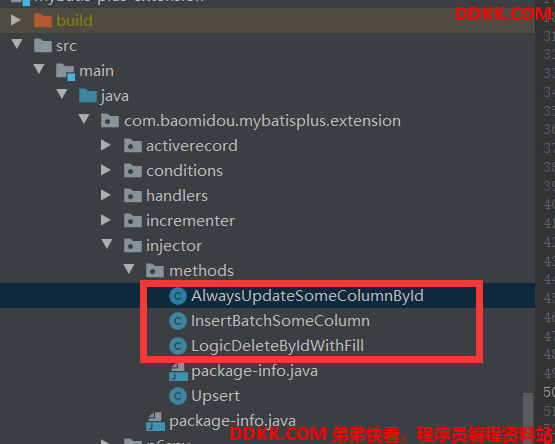Mybatis执行流程
1、 加载配置:配置来源于两个地方,一处是配置文件,一处是Java代码的注解,将SQL的配置信息加载成为一个个MappedStatement对象(包括了传入参数映射配置、执行的SQL语句、结果映射配置),存储在内存中;
2、 SQL解析:当API接口层接收到调用请求时,会接收到传入SQL的ID和传入对象(可以是Map、JavaBean或者基本数据类型),Mybatis会根据SQL的ID找到对应的MappedStatement,然后根据传入参数对象对MappedStatement进行解析,解析后可以得到最终要执行的SQL语句和参数;
3、 SQL执行:将最终得到的SQL和参数拿到数据库进行执行,得到操作数据库的结果;
4、 结果映射:将操作数据库的结果按照映射的配置进行转换,可以转换成HashMap、JavaBean或者基本数据类型,并将最终结果返回;

Plus中的默认SQL注入器
1、 SQL注入器相关源码在core包下;
 2、 SelectById对象源码;
2、 SelectById对象源码;
/**
* 根据ID 查询一条数据
*
* @author DDKK.COM 弟弟快看,程序员编程资料站
* @since 2018-04-06
*/
public class SelectById extends AbstractMethod {
/**
*
* @param mapperClass mapper 接口
* @param modelClass mapper 泛型
* @param tableInfo 数据库表反射信息
* @return
*/
@Override
public MappedStatement injectMappedStatement(Class<?> mapperClass, Class<?> modelClass, TableInfo tableInfo) {
// 获取通用SQL语句: SELECT_BY_ID("selectById", "根据ID 查询一条数据", "SELECT %s FROM %s WHERE %s=#{%s} %s"),
SqlMethod sqlMethod = SqlMethod.SELECT_BY_ID;
// 根据相关信息构造SQL sqlSource=》处理SQL
// SELECT id,user_id,commodity_code,count,money,dept_id,tenant_id,is_deleted,version,oper_user,gmt_create,gmt_modified FROM order_tbl WHERE id=? AND is_deleted=0
SqlSource sqlSource = new RawSqlSource(configuration,
String.format(sqlMethod.getSql(), // 格式化SQL语句
sqlSelectColumns(tableInfo, false), // 获取查询列
tableInfo.getTableName(), tableInfo.getKeyColumn(), tableInfo.getKeyProperty(), // 表名
tableInfo.getLogicDeleteSql(true, true)), Object.class); // 处理逻辑删除
//
return this.addSelectMappedStatementForTable(mapperClass, getMethod(sqlMethod), sqlSource, tableInfo);
}
}
1、 AbstractSqlInjector源码;
public abstract class AbstractSqlInjector implements ISqlInjector {
private static final Log logger = LogFactory.getLog(AbstractSqlInjector.class);
/**
* 检查SQL是否注入(已经注入过不再注入)
*
* @param builderAssistant mapper 信息
* @param mapperClass mapper 接口的 class 对象
*/
@Override
public void inspectInject(MapperBuilderAssistant builderAssistant, Class<?> mapperClass) {
// 获取实体类Class
Class<?> modelClass = extractModelClass(mapperClass);
if (modelClass != null) {
// 获取Mapper接口Class名
String className = mapperClass.toString();
// Mapper注册表缓存
Set<String> mapperRegistryCache = GlobalConfigUtils.getMapperRegistryCache(builderAssistant.getConfiguration());
// 缓存中没有当前Mapper接口
if (!mapperRegistryCache.contains(className)) {
// 获取 注入的方法集合
List<AbstractMethod> methodList = this.getMethodList(mapperClass);
if (CollectionUtils.isNotEmpty(methodList)) {
// 获取表信息
TableInfo tableInfo = TableInfoHelper.initTableInfo(builderAssistant, modelClass);
// 循环注入自定义方法
methodList.forEach(m -> m.inject(builderAssistant, mapperClass, modelClass, tableInfo));
} else {
logger.debug(mapperClass.toString() + ", No effective injection method was found.");
}
mapperRegistryCache.add(className);
}
}
}
/**
* <p>
* 获取 注入的方法
* </p>
*
* @param mapperClass 当前mapper
* @return 注入的方法集合
* @since 3.1.2 add mapperClass
*/
public abstract List<AbstractMethod> getMethodList(Class<?> mapperClass);
/**
* 提取泛型模型,多泛型的时候请将泛型T放在第一位
*
* @param mapperClass mapper 接口
* @return mapper 泛型
*/
protected Class<?> extractModelClass(Class<?> mapperClass) {
Type[] types = mapperClass.getGenericInterfaces();
ParameterizedType target = null;
for (Type type : types) {
if (type instanceof ParameterizedType) {
Type[] typeArray = ((ParameterizedType) type).getActualTypeArguments();
if (ArrayUtils.isNotEmpty(typeArray)) {
for (Type t : typeArray) {
if (t instanceof TypeVariable || t instanceof WildcardType) {
break;
} else {
target = (ParameterizedType) type;
break;
}
}
}
break;
}
}
return target == null ? null : (Class<?>) target.getActualTypeArguments()[0];
}
}
1、 Debug可发现,这些通用的方法都注册到MappedStatement集合中,可以通过Mapper直接调用;

分析MybatisPlus的sql注入器
通过mybatis流程及plus源码分析,可以知道以下几点:
- 可以自定义注入通用 SQL 语句方法
- 自定义一个基础的Mapper然后继承 BaseMapper 添加自定义方法
- 全局配置 sqlInjector 注入 MP 会自动将类所有方法注入到 mybatis 容器中。
- 这样就可以各个业务Mapper只需要继承基础Mapper,就可以调用公用方法。
测试案例
1. 基础环境
1、 定义一个基础Mapper并继承BaseMapper;
public interface MyBaseMapper<T> extends BaseMapper<T> {
int deleteByIdWithFill(T entity);
}
1、 业务Mapper继承自定义Mapper;
@Mapper
public interface OrderTblMapper extends MyBaseMapper<OrderTbl> {
}
1、 自定义一个SQL注入器,用于添加自定义方法;
@Component
public class MySqlInjector extends DefaultSqlInjector {
@Override
public List<AbstractMethod> getMethodList(Class<?> mapperClass) {
List<AbstractMethod> methodList = super.getMethodList(mapperClass);
return methodList;
}
}
2. 添加默认的装载器
1、 Plus扩展包提供了几个内置选装件,可以直接拿来使用;
 2、 修改MySqlInjector注入器,添加内置选装件;
2、 修改MySqlInjector注入器,添加内置选装件;
@Component
public class MySqlInjector extends DefaultSqlInjector {
@Override
public List<AbstractMethod> getMethodList(Class<?> mapperClass) {
List<AbstractMethod> methodList = super.getMethodList(mapperClass);
// 添加内置选装件
methodList.add(new InsertBatchSomeColumn(i -> i.getFieldFill() != FieldFill.UPDATE));
methodList.add(new AlwaysUpdateSomeColumnById());
methodList.add(new LogicDeleteByIdWithFill());
return methodList;
}
}
1、 MyBaseMapper添加方法;
public interface MyBaseMapper<T> extends BaseMapper<T> {
int insertBatchSomeColumn(List<T> entityList);
int alwaysUpdateSomeColumnById(@Param(Constants.ENTITY) T entity);
int deleteByIdWithFill(T entity);
}
1、 insertBatchSomeColumn说明及注意事项:;
(1)如果个别字段在 entity 里为 null 但是数据库中有配置默认值, insert 后数据库字段是为 null 而不是默认值
(2)这个方法,会把entity存在的字段都插入,如果某个字段没有值时,会插入NULL。
/**
* 普通Insert: Execute SQL:INSERT INTO order_tbl ( user_id, commodity_code, money, oper_user, gmt_create, gmt_modified ) VALUES ( '123', 'PHONE', 100, 'zhangsan', '2021-03-31T13:10:45.240', '2021-03-31T13:10:45.242' )
* Execute SQL:INSERT INTO order_tbl (user_id,commodity_code,count,money,dept_id,tenant_id,is_deleted,version,oper_user,gmt_create,gmt_modified) VALUES ('123','PHONE',NULL,100,NULL,NULL,NULL,NULL,'zhangsan','2021-03-31T13:09:31.011','2021-03-31T13:09:31.014')
*/
@Test
public void insertBatchSomeColumnTest() {
List<OrderTbl> list = new ArrayList<>();
for (int i = 0; i < 100; i++) {
OrderTbl orderTbl = new OrderTbl().setMoney(100).setUserId("123").setCommodityCode("PHONE");
list.add(orderTbl);
}
orderTblMapper.insertBatchSomeColumn(list);
}
1、 alwaysUpdateSomeColumnById说明及注意事项:;
(1)根据 ID 更新固定的那几个字段(但是不包含逻辑删除)
(2)这个方法,会把entity存在的字段都更新,如果某个字段没有值时,更新为NULL。
@Test
public void alwaysUpdateSomeColumnByIdTest() {
OrderTbl orderTbl = new OrderTbl().setMoney(100).setUserId("123").setCommodityCode("PHONE");
orderTblMapper.alwaysUpdateSomeColumnById(orderTbl);
}
1、 deleteByIdWithFill说明及注意事项:;
(1)根据 id 逻辑删除数据,并带字段填充功能
(2)注意入参是 entity !!! ,如果字段没有自动填充,就只是单纯的逻辑删除
@Test
public void deleteByIdWithFillTest() {
OrderTbl orderTbl1 = orderTblMapper.selectById(18587);
orderTbl1.setMoney(100);
orderTblMapper.deleteByIdWithFill(orderTbl1);
}
3. 自定义公用方法
1、 自定义方法继承AbstractMethod;
public class FindOne extends AbstractMethod {
@Override
public MappedStatement injectMappedStatement(Class<?> mapperClass, Class<?> modelClass, TableInfo tableInfo) {
/* 执行 SQL ,动态 SQL 参考类 SqlMethod */
String sql = "select * from " + tableInfo.getTableName()
+ " where " + tableInfo.getKeyColumn() + "=#{" + tableInfo.getKeyProperty() + "}";
/* mapper 接口方法名一致 */
String method = "findOne";
SqlSource sqlSource = languageDriver.createSqlSource(configuration, sql, modelClass);
return addSelectMappedStatementForTable(mapperClass, method, sqlSource, tableInfo);
}
}
1、 MySqlInjector添加自定义方法;
// 添加自定义方法
methodList.add(new FindOne());
1、 MyBaseMapper中添加自定义方法;
T findOne(Serializable id);
1、 测试:;
@Test
public void findOneTest() {
OrderTbl one = orderTblMapper.findOne(18587);
}